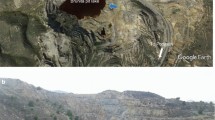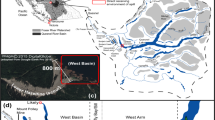Abstract
Whether the extreme conditions of acidity and heavy metal pollution of streams and rivers originating in pyritic formations are caused primarily by mining activities or by natural activities of metal-oxidizing microbes living within the geological formations is a subject of considerable controversy. Most microbiological studies of such waters have so far focused on acid mine drainage sites, which are heavily human-impacted environments, so it has been problematic to eliminate the human factor in the question of the origin of the key metal compounds. We have studied the physico-chemistry and microbiology of the Río Sucio in the Braulio Carrillo National Park of Costa Rica, 22 km from its volcanic rock origin. Neither the remote origin, nor the length of the river to the sampling site, have experienced human activity and are thus pristine. The river water had a characteristic brownish-yellow color due to high iron-dominated minerals, was slightly acidic, and rich in chemolithoautotrophic iron- and sulfur-oxidizing bacteria, dominated by Gallionella spp. Río Sucio is thus a natural acid-rock drainage system whose metal-containing components are derived primarily from microbial activities.





Similar content being viewed by others
References
Amils R, Fernández-Remolar D, The IPBSL Team (2014) Río Tinto: a geochemical and mineralogical terrestrial analogue of Mars. Life 4:511–534
Baker BJ, Banfield JF (2003) Microbial communities in acid mine drainage. FEMS Microbiol Ecol 44:139–152
Bakoyannakis DN, Deliyanni EA, Zouboulis AI et al (2003) Akaganeite and goethite-type nanocrystals: synthesis and characterization. Microporous Mesoporous Mater 59:35–42
Bigham JM, Schwertmann U, Carlson L et al (1990) A poorly crystallized oxyhydroxysulfate of iron formed by bacterial oxidation of Fe(II) in acid mine waters. Geochim Cosmochim Acta 54:2743–2758
Bohorquez LC, Delgado-Serrano L, López G et al (2012) In-depth characterization via complementing culture-independent approaches of the microbial community in an acidic hot spring of the Colombian Andes. Microb Ecol 63:103–115
Bruneel O, Duran R, Casiot C et al (2006) Diversity of microorganisms in Fe–As-rich acid mine drainage waters of Carnoulès, France. Appl Environ Microbiol 72:551–556
Burbach K, Seifert J, Pieper DH et al (2016) Evaluation of DNA extraction kits and phylogenetic diversity of the porcine gastrointestinal tract based on Illumina sequencing of two hypervariable regions. Microbiologyopen 5:70–82
Camarinha-Silva A, Jáuregui R, Chaves-Moreno D et al (2014) Comparing the anterior nare bacterial community of two discrete human populations using Illumina amplicon sequencing. Environ Microbiol 16:2939–2952
Castellón E, Martínez M, Madrigal-Carballo S et al (2013) Scattering of light by colloidal aluminosilicate particles produces the unusual sky-blue color of Río Celeste (Tenorio Volcano complex, Costa Rica). PLoS One 8:e75165
Dold B, González-Toril E, Aguilera A et al (2013) Acid rock drainage and rock weathering in antarctica: important sources for iron cycling in the southern ocean. Environ Sci Technol 47:6129–6136
Edgar RC, Haas BJ, Clemente JC et al (2011) UCHIME improves sensitivity and speed of chimera detection. Bioinformatics 27:2194–2200
Edwards KJ, Rodgers TM, Schrenk MO et al (1999) Geomicrobiology of pyrite (FeS2) dissolution: case study at Iron Mountain, California. Geomicrobiol J 16:155–179
Fabisch M, Beulig F, Akob DM et al (2013) Surprising abundance of Gallionella-related iron oxidizers in creek sediments at pH 4.4 or at high heavy metal concentrations. Front Microbiol 4:390
Farrand WH (1997) Identification and mapping of ferric oxide and oxyhydroxide minerals in imaging spectrometer data of Summitville, Colorado, USA, and the surrounding San Juan Mountains. Int J Remote Sens 18:1543–1552
Fernández-Martínez A, Timon V, Romaman-Ross G et al (2010) The structure of schwertmannite, a nanocrystalline iron oxyhydroxysulfate. Am Mineral 95:1312–1322
Fernández-Remolar DC (2003) Geological record of an acidic environment driven by iron hydrochemistry: the Tinto River system. J Geophys Res 108:1–15
García-Moyano A, González-Toril E, Ángeles Aguilera et al (2012) Comparative microbial ecology study of the sediments and the water column of the Río Tinto, an extreme acidic environment. FEMS Microbiol Ecol 81:303–314
González-Toril E, Llobet-Brossa E, Casamayor EO et al (2003) Microbial ecology of an extreme acidic environment, the Tinto River. Appl Environ Microbiol 69:4853–4865
González-Toril E, Santofimia E, Blanco Y et al (2015) Pyrosequencing-based assessment of the microbial community structure of Pastoruri glacier area (Huascarán National Park, Perú), a natural extreme acidic environment. Microb Ecol 70:936–947
Haaijer SCM, Harhangi HR, Meijerink BB et al (2008) Bacteria associated with iron seeps in a sulfur-rich, neutral pH, freshwater ecosystem. ISME J 2:1231–1242
He Z, Xiao S, Xie X et al (2007) Molecular diversity of microbial community in acid mine drainages of Yunfu sulfide mine. Extremophiles 11:305–314
Hedrich S, Lunsdorf H, Kleeberg R et al (2011) Schwertmannite formation adjacent to bacterial cells in a mine water treatment plant and in pure cultures of Ferrovum myxofaciens. Environ Sci Technol 45:7685–7692
Heinzel E, Hedrich S, Janneck E et al (2009) Bacterial diversity in a mine water treatment plant. Appl Environ Microbiol 75:858–861
Johnson DB (1998) Biodiversity and ecology of acidophilic microorganisms. FEMS Microbiol Ecol 27:307–317
Johnson DB, Hallberg KB (2005) Acid mine drainage remediation options: a review. Sci Total Environ 338:3–14
Jones DS, Kohl C, Grettenberger C et al (2015) Geochemical niches of iron-oxidizing acidophiles in acidic coal mine drainage. Appl Environ Microbiol 81:1242–1250
Kimura S, Bryan CG, Hallberg KB et al (2011) Biodiversity and geochemistry of an extremely acidic, low-temperature subterranean environment sustained by chemolithotrophy. Environ Microbiol 13:2092–2104
Kozich JJ, Westcott SL, Baxter NT et al (2013) Development of a dual-index sequencing strategy and curation pipeline for analyzing amplicon sequence data on the miseq illumina sequencing platform. Appl Environ Microbiol 79:5112–5120
López-Archilla AI, Gérard E, Moreira D et al (2004) Macrofilamentous microbial communities in the metal-rich and acidic River Tinto, Spain. FEMS Microbiol Lett 235:221–228
Lütters-Czekalla S (1990) Lithoautotrophic growth of the iron bacterium Gallionella ferruginea with thiosulfate or sulfide as energy source. Arch Microbiol 154:417–421
Montero W, Denyer P, Barquero R et al. (1998) Map of Quaternary Faults and Folds of Costa Rica. United States Geological Survey, Open-file report 98–481. http://pubs.usgs.gov/of/1998/ofr-98-0481/. Accessed 4 Dec 2015
Olías M, Nieto JM (2015) Background conditions and mining pollution throughout history in the Río Tinto (SW Spain). Environments 2:295–316
Pronk JT, De Bruyn JC, Bos P et al (1992) Anaerobic growth of Thiobacillus ferrooxidans. Appl Environ Microbiol 58:2227–2230
Pruesse E, Peplies J, Glöckner FO (2012) SINA: accurate high-throughput multiple sequence alignment of ribosomal RNA genes. Bioinformatics 28:1823–1829
Puente-Sánchez F, Aguirre J, Parro V (2016) A novel conceptual approach to read-filtering in high-throughput amplicon sequencing studies. Nucleic Acids Res 44:e40
Quast C, Pruesse E, Yilmaz P et al (2013) The SILVA ribosomal RNA gene database project: improved data processing and web-based tools. Nucleic Acids Res 41:D590–D596
Sánchez-Andrea I, Rodríguez N, Amils R et al (2011) Microbial diversity in anaerobic sediments at Río Tinto, a naturally acidic environment with a high heavy metal content. Appl Environ Microbiol 77:6085–6093
Sánchez-Andrea I, Rojas-Ojeda P, Amils R et al (2012) Screening of anaerobic activities in sediments of an acidic environment: tinto River. Extremophiles 16:829–839
Schloss PD, Westcott SL, Ryabin T et al (2009) Introducing mothur: open-source, platform-independent, community-supported software for describing and comparing microbial communities. Appl Environ Microbiol 75:7537–7541
Straub KL, Benz M, Schink B (2000) Iron metabolism in anoxic environments at near neutral pH. FEMS Microbiol Ecol 34:181–186
Suzuki I, Takeuchi TL, Yuthasastrakosol TD et al (1990) Ferrous iron and sulfur oxidation and ferric iron reduction activities of Thiobacillus ferrooxidans are affected by growth on ferrous iron, sulfur, or a sulfide ore. Appl Environ Microbiol 56:1620–1626
Tamura K, Stecher G, Peterson D et al (2013) MEGA6: molecular evolutionary genetics analysis version 6.0. Mol Biol Evol 30:2725–2729
Tischler JS, Jaffer R, Gelhaar N et al (2013) New cultivation medium for “Ferrovum” and Gallionella-related strains. J Microbiol Methods 95:138–144
Wang Q, Garrity GM, Tiedje JM et al (2007) Naive Bayesian classifier for rapid assignment of rRNA sequences into the new bacterial taxonomy. Appl Environ Microbiol 73:5261–5267
Acknowledgements
We are grateful to Ricardo Amils from the Astrobiology Centre (CSIC-INTA) for critical comments and helpful suggestions on this manuscript, and Raul Mora and Carlos Ramírez of the Costa Rican National Seismological Network (RSN) for inspiring conversations. We also thank to Rolando Mora from Escuela Centroamericana de Geología (Universidad de Costa Rica) by providing information about the origin of Río Sucio and Solange Voysest for help in the design of some figures.
Author information
Authors and Affiliations
Corresponding author
Ethics declarations
Funding
This work was supported by resources of the Vice-rectory of Research of Universidad de Costa Rica (809-B4-282) and by the ERC grant IPBSL (ERC250350-IPBSL) to Ricardo Amils and Kenneth N. Timmis. Computational resources were provided by the Data Intensive Academic Grid, which is supported by the USA National Science Foundation (0959894). F.P.S. was supported by a JAE-pre fellowship from the Spanish Consejo Superior de Investigaciones Científicas (CSIC) and the European Union FP7 programme Grant Agreement (607346).
Additional information
Communicated by M. da Costa.
Electronic supplementary material
Below is the link to the electronic supplementary material.
Rights and permissions
About this article
Cite this article
Arce-Rodríguez, A., Puente-Sánchez, F., Avendaño, R. et al. Pristine but metal-rich Río Sucio (Dirty River) is dominated by Gallionella and other iron-sulfur oxidizing microbes. Extremophiles 21, 235–243 (2017). https://doi.org/10.1007/s00792-016-0898-7
Received:
Accepted:
Published:
Issue Date:
DOI: https://doi.org/10.1007/s00792-016-0898-7




